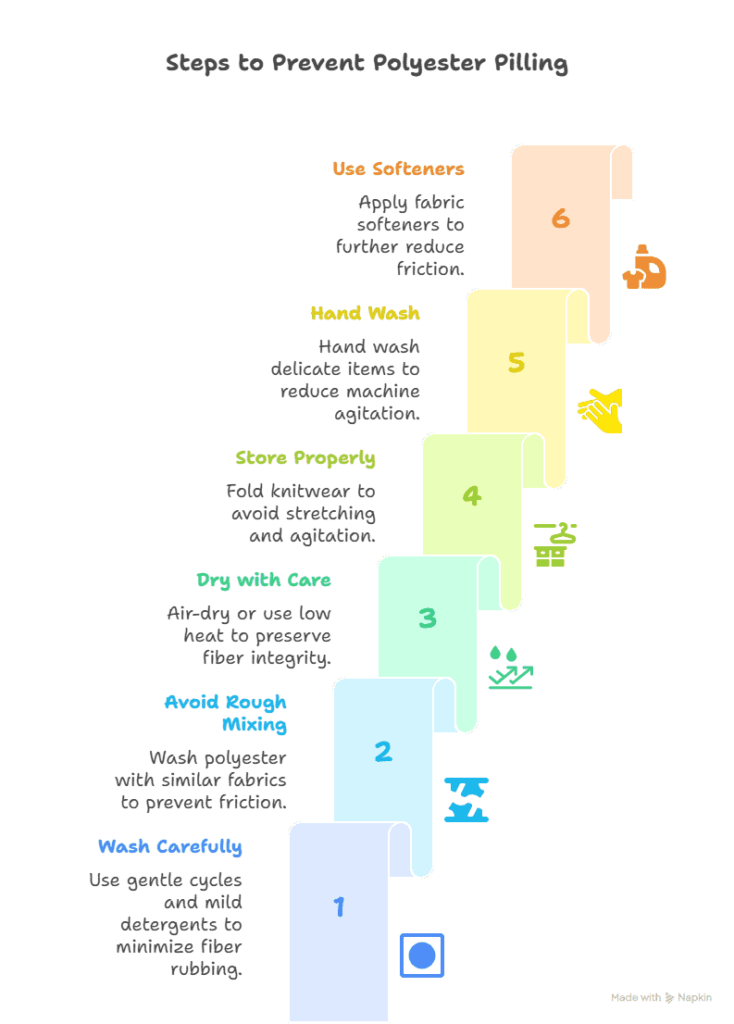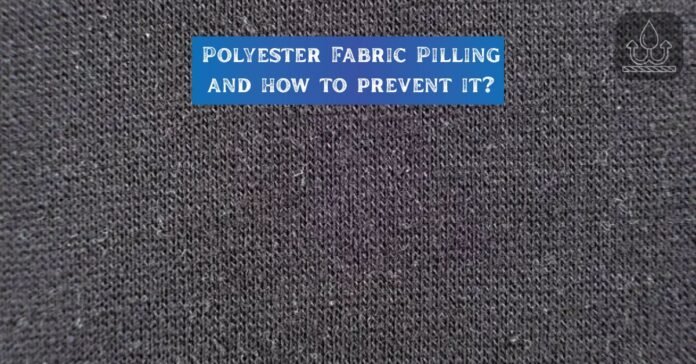Yes, polyester can pill, though generally less than many natural fabrics. Pilling refers to small balls of fiber that form on a fabric surface. These pills often result from fiber ends breaking and tangling together. For example, friction from wear or washing causes polyester fibers to break. These loose fibers then knot into tiny fuzz balls. Understanding pilling is key. Therefore, this article explains why polyester pills. For example, it shows how to prevent and remove these pills.
What is Pilling?
For example, pilling can affect any textile. Sweaters, pants, blankets, and even furniture upholstery can develop pills. For example, pilling means little clusters or balls of fiber on a fabric’s surface. When fibers break loose, they knit into tiny lint balls. Pilling is common in many textiles – especially those made of synthetic fibers and blends. Under repeated wear or washing, polyester fibers can loosen and tangle, forming visible pills. In everyday terms, pilling appears as small fluff balls on a sweater. For example, they feel rough to the touch and make clothes look worn.
For example, rubbing a polyester sweatshirt against a seat or another fabric can produce pills. Abrasion from friction is the main culprit. In other words, when polyester rubs against other fabrics, loose fibers may break off and form pills. It makes clothing look aged. However, it does not mean the fabric is ruined.
Does Polyester Pill?
In fact, yes – polyester does pill. Polyester is one of the synthetic fibers known to be prone to pilling. However, polyester’s strong, smooth fibers often hold pills anchored so they don’t shed easily. That means pure polyester may resist pilling better than short-fiber fabrics. Studies have shown that polyester yarns can pill more than cotton. For example, acrylic fibers pill even more than polyester.
A 100% polyester garment will often pill less than a polyester blend. Also, a cotton-polyester mix tends to pill more, because the fibers move differently under friction. Likewise, long-staple cotton is more resistant to pilling than short polyester fibers. In practice, 100% polyester usually resists pilling better than a similar blend or shorter-fiber shirt. It can still develop pills under rough use.
Polyester vs other Fabrics which pills more?
Other synthetics like acrylic also pill frequently. Conversely, natural fibers such as linen or long-staple cotton resist pilling much better.
| Fabric | Pilling Tendency |
|---|---|
| Polyester | Moderate. Strong smooth fibers hold pills once formed. Prone to pilling under abrasion. |
| Cotton | Low to Moderate. Long-staple cotton resists pills, but short cotton may pill over time. |
| Wool | High. Wool fibers are coarse and shed easily, causing pills. Quality (e.g. cashmere) changes the outcome. |
Why Does Polyester Pill? (Causes)
Pilling in polyester mainly comes down to how the fibers behave under stress. Three key factors cause polyester to pill:
- Friction and Wear: In particular, repeated rubbing or abrasion makes polyester pill. When you wear, wash, or handle polyester clothing, the surface fibers break and tangle. For instance, a polyester shirt rubbing against a rough backpack strap can loosen fibers. Each wash cycle also applies friction. Over time, these loose fibers knot together, forming visible pills.
- Fiber Quality and Construction: Additionally, low-quality polyester fabrics use shorter, weaker fibers that pill easily. High-quality polyester uses long filament yarns that hold together better. A loosely knit or woven polyester will pill faster because fibers can work free more easily. For example, knitted polyester tends to pill more than woven fabrics. A tight weave holds fibers in place. It prevents pills. In short, the stronger and longer the polyester fibers, the less they break and pill.
- Blends and Fiber Mixtures: Also, mixing polyester with other fibers often increases pilling. In blended fabrics (like polyester-cotton or polyester-wool), the different fibers respond differently to stress. Polyester’s strength can trap the loose fibers of the natural component, so pills stick to the surface. For example, a cotton-polyester sweater pills more than one made of pure cotton or pure polyester. Essentially, blends often pill more easily.
Other factors include washing with very hot water or harsh chemicals, which can weaken polyester. Also, polyester’s tendency to attract oils can worsen pilling over time. However, friction and fiber quality remain the biggest causes.
How to Prevent Polyester from Pilling
The secret of pilling prevention in polyester is related to minimization of abrasion and stress. By taking good care, reducing pills is highly possible:

- Wash carefully: Over all, polyester clothing should be washed inside out. Hand wash cold with a gentle/delicate cycle. Gentle cycles and low temperatures lessen the rubbing of fibers. Always use a mild liquid detergent. Harsh powders or bleach can weaken fibers and encourage pilling.
- Avoid Rough Mixing: Also, wash polyester with similar fabrics. Do not mix soft knits with rough items like denim or towels. Rough fabrics create friction that pulls out polyester fibers. You can also use a mesh laundry bag for delicate polyester pieces to protect them.
- Dry with Care: Instead of high heat, air-dry polyester items or tumble dry on low. High heat and tumbling cause garments to rub against the dryer drum, increasing pilling. By air drying or using low heat, you preserve fiber integrity.
- Store Properly: Similarly, fold knitwear and polyester sweaters rather than hang them. Folding avoids constant agitation and stretching of the fabric. Also, keep polyester garments away from zippers, Velcro, or sharp accessories that might rub and form pills.
- Hand Wash (Delicate Care): As an extra step, hand wash delicate polyester items. This can reduce pilling by avoiding the agitation of a machine. Wash in cool water with gentle detergent. For example, avoid wringing to lessen fiber stress.
- Use Softeners: Finally, if desired, a fabric softener or anti-static spray can further reduce friction. Some detergents are formulated for synthetics and can help coat fibers. This is an extra step, but it may help prevent new pills.
By following these precautions, you create a gentler environment for polyester. Over time, this significantly slows the pilling process.
How to Remove Polyester Pills (Fixes)
In case there are pills, it is something that can be solved. These are the best methods of removal:
Fabric Shaver (Electric De-Piller): A good solution is a hand held fabric shaver. Pass the shaver against the fabric at a low speed, which cuts pills off. This scrubs safe off fuzz without ripping the cloth. Apply gentle pressure to the machine every time you use it instead of pressing hard on fabrics, which will cause destruction.
Lint Roller or Tape: One more trick is to pick small pills off of polyester with a sticky lint roller or wide adhesive tape. It only needs to be rolled or pressed on the fabric with the sticky side and removed. This can be applied to removal of spots, or removal of fine hairs remaining after shavings.
Pilling Comb or Razor: A manual pilling comb is a small tool with fine teeth that catches pills when you brush the garment. Alternatively, a clean disposable razor can remove pills. With the fabric stretched flat, gently run the razor at a shallow angle across the surface. This method requires care: too much pressure can cut holes. Work slowly to shave off pills.
Gentle Brushing: Finally, after washing, brushing the surface with a soft clothes brush can catch loose pills before they clump. Use light strokes to pick up fuzz early.
Pre-treatments: Also, in the future washes, combine a soft detergent, formulated on synthetics and a little fabric conditioner. These products may cover the fibers and decrease the friction in the washing, that indirectly prevents the creation of new pills.
All these remedies are quick to revive the appearance of a polyester piece. Best results are achieved when the pills are removed as they manifest. Constant repair also maintains the surface smooth and fresh.
Is Pilled Polyester Unwearable?
Not at all. Finally, pilling is mostly cosmetic and does not injure wearability. That is, even when pill on a polyester sweater or jacket, it is still robust. It is just simply a bit fuzzy. The pills may be taken out (as per the above) and the garment will come out just alright. Similarly, shared even high quality fibers such as the cashmere pill as the experts explain. High-quality polyester having long fibers may not pill quickly. Anyway, pilling should not to be an indication of fabric failure.
Moreover, there is no reason why a piece of clothing will be useless because of pilling. It does not apply a severe loss on the material in a single use. The polyester surface will become smooth when you cut the pills carefully or using fingers to pluck them off. Thus, do not rush to throw away a favorite item made of polyester on account of some pills. On the contrary, take care of the pills and wear it. Pilling is merely a cosmetic hazard, and it is not a deal-breaker.
Conclusion & Tips
To conclude, there is a possibility of polyester fabrics pilling, though this problem is manageable. Pills are primarily based on friction and pathetic fibers. Polyester can be washed carefully (inside-out, cold with gentle cycle, fabric shavers, etc.) to prevent the formation of pills. It is important to remember that pilling only superficial. As an example, throwing pills away and using any of the indicated care tips will prolong the life cycle of your clothing.
Have you ever faced polyester pilling? As a sample, give your experience or suggestions in comment sections below. And we will be glad to know what best suits you. E.g. caring will make your favorite polyester products remain soft, smooth, with no pills.
Read More>> About the stretchiness of Polyester.
FAQs
No, less than cotton do polyester pills. The natural fibers in cotton are less durable than in polyester; thus, it tends to break easily when worn or washed whereas the synthetic fibers used in polyester are sturdier and they cannot pill.
Although polyester is quite durable, it may still pill through washing, or wearing or rubbing against rough surfaces. Pilling is more common with low quality polyester and blended material.
Washing inside out, washing in cold water and gentle washing detergent, avoiding tumble drying and avoiding washing polyester with abrasive materials such as denim fabrics and towels will also help to prevent pilling.
Yes you can remove pills safely with a fabric shaver, pilling comb or gentle razor. These tools will assist in making the fabric smooth again without spoiling the material.
Not always. Although cheap polyester pills more because of the short fibers, even expensive fabric will pill unless special care is given to it. The risk is greatly minimized by proper handling and washing.

[…] Intensive scrubbing or hard brushes may bend the polyester fiber and may result in snags or pilling. Apply light movements to rub out a stain. Too much pressure may destroy the surface of fabrics, […]